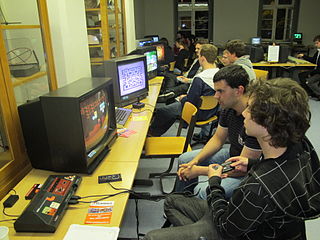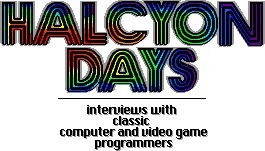 | |
| Author | Tristan Donovan |
|---|---|
| Subject | history of video games |
| Published | April 20, 2010 |
| Publisher | Yellow Ant |
| Pages | 513 |
| ISBN | 978-0-9565072-0-4 |
Replay: The History of Video Games is a book on the history of video games by Tristan Donovan.
 | |
| Author | Tristan Donovan |
|---|---|
| Subject | history of video games |
| Published | April 20, 2010 |
| Publisher | Yellow Ant |
| Pages | 513 |
| ISBN | 978-0-9565072-0-4 |
Replay: The History of Video Games is a book on the history of video games by Tristan Donovan.
Donovan interviewed over 140 game developers and businesspeople for the book. [1] The book's advertising campaign, led by Cathy Campos, was recognized in PR Week . [2]
Multiple journalists praised the book's treatment of European game history, which had been neglected in previous works, [3] [4] and criticized its organizational structure. [3] At the time of its release, Chris Baker of Wired wrote that Replay was the most thorough and comprehensive history of the subject. [4] Colin Moriarty of IGN noted the book's generalist position in relation to other game histories, as of 2014. He added that Donovan's thoroughness made for an interesting story about the industry's humble origins. Moriarty appreciated Donovan's approach to the European computer-centric and pre-console history as a departure from the litany of publications on early American companies and Japan's entry into the American market. [3]

Asteroids is a space-themed multidirectional shooter arcade video game designed by Lyle Rains and Ed Logg released in November 1979 by Atari, Inc. The player controls a single spaceship in an asteroid field which is periodically traversed by flying saucers. The object of the game is to shoot and destroy the asteroids and saucers, while not colliding with either, or being hit by the saucers' counter-fire. The game becomes harder as the number of asteroids increases.

Doom is a first-person shooter game developed and published by id Software. Released on December 10, 1993, for DOS, it is the first installment in the Doom franchise. The player assumes the role of a space marine, later unofficially referred to as Doomguy, fighting through hordes of undead humans and invading demons. The game begins on the moons of Mars and finishes in hell, with the player traversing each level to find its exit or defeat its final boss. It is an early example of 3D graphics in video games, and has enemies and objects as 2D images, a technique sometimes referred to as 2.5D graphics.
Infocom was an American software company based in Cambridge, Massachusetts, that produced numerous works of interactive fiction. They also produced a business application, a relational database called Cornerstone.

Loom is a 1990 fantasy-themed graphic adventure game by Lucasfilm Games. The project was led by Brian Moriarty, a former Infocom employee and author of classic text adventures Wishbringer (1985), Trinity (1986), and Beyond Zork (1987). It was the fourth game to use the SCUMM adventure game engine, and the first of those to avoid the verb–object interface introduced in Maniac Mansion.

Roberta Lynn Williams is an American video game designer and writer, who co-founded Sierra On-Line with her husband, game developer Ken Williams. In 1980, her first game, Mystery House, became a modest commercial success; it is credited as the first graphic adventure game. She is also known for creating and maintaining the King's Quest series, as well as designing the full motion video game Phantasmagoria in 1995.

Yu Suzuki is a Japanese game designer, producer, programmer, and engineer, who headed Sega's AM2 team for 18 years. Considered one of the first auteurs of video games, he has been responsible for a number of Sega's arcade hits, including three-dimensional sprite-scaling games that used "taikan" motion simulator arcade cabinets, such as Hang-On, Space Harrier, Out Run and After Burner, and pioneering polygonal 3D games such as Virtua Racing and Virtua Fighter, which are some of the games besides others from rival companies during that era credited with popularizing 3D graphics in video games; as well as the critically acclaimed Shenmue series. As a hardware engineer, he led the development of various arcade system boards, including the Sega Space Harrier, Model 1, Model 2 and Model 3, and was involved in the technical development of the Dreamcast console and its corresponding NAOMI arcade hardware.
1983 has seen many sequels and prequels in video games, such as Mario Bros. and Pole Position II, along with new titles such as Astron Belt, Champion Baseball, Dragon's Lair, Elevator Action, Spy Hunter and Track & Field. Major events include the video game crash of 1983 in North America, and the third generation of video game consoles beginning with the launch of Nintendo's Family Computer (Famicom) and Sega's SG-1000 in Japan. The year's highest-grossing video game was Namco's arcade game Pole Position, while the year's best-selling home system was Nintendo's Game & Watch for the third time since 1980.

Brian Moriarty is an American video game developer who authored three of the original Infocom interactive fiction titles, Wishbringer (1985), Trinity (1986), and Beyond Zork (1987), as well as Loom (1990) for LucasArts.

OXO is a video game developed by A S Douglas in 1952 which simulates a game of noughts and crosses (tic-tac-toe). It was one of the first games developed in the early history of video games. Douglas programmed the game as part of a thesis on human-computer interaction at the University of Cambridge.

Retrogaming, also known as classic gaming and old school gaming, is the playing and collection of obsolete personal computers, consoles, and video games. Usually, retrogaming is based upon systems that are outmoded or discontinued, although ported retrogaming allows games to be played on modern hardware via ports or compilations. It is typically for nostalgia, preservation, or authenticity. A new game could be retro styled, such as an RPG with turn-based combat and pixel art in isometric camera perspective.
Virtua Fighter is a series of fighting games created by Sega AM2 and designer Yu Suzuki. The original Virtua Fighter was released in December 1993 and has received four main sequels and several spin-offs. The highly influential first Virtua Fighter game is widely recognized as the first 3D fighting game released.

Brenda Louise Romero, previously known as Brenda Brathwaite, is an American game designer and developer in the video game industry. She was born in Ogdensburg, New York and is a graduate of Clarkson University. Romero is best known for her work on the Wizardry series of role-playing video games and, more recently, the non-digital series The Mechanic is the Message. She has worked in game development since 1981 and has credits on 49 game titles.
Rob Fulop is an American game programmer who created two of the Atari 2600's biggest hits: the port of arcade game Missile Command and 1982's Demon Attack, which won Electronic Games' Game of the Year award. While at Atari, Fulop also ported Night Driver to the 2600 and Space Invaders to the Atari 8-bit computers.
The concept of video games as a form of art is a commonly debated topic within the entertainment industry. Though video games have been afforded legal protection as creative works by the Supreme Court of the United States, the philosophical proposition that video games are works of art remains in question, even when considering the contribution of expressive elements such as acting, visuals, stories, interaction and music. Even art games, games purposely designed to be a work of creative expression, have been challenged as works of art by some critics.
Jamie Faye Fenton is a game programmer best known for the 1981 arcade game Gorf and for being one of the creators of MacroMind's VideoWorks software. Jamie has been active in the transgender community and transitioned from male to female around 1998.

Halcyon Days: Interviews with Classic Computer and Video Game Programmers is a digital book edited by James Hague and published in 1997. The book was originally formatted using HTML and sold via mail-order, shipped on a floppy disk by Dadgum Games for USD $20. In 2002, Halcyon Days was made freely available on the web. The book continued to be sold by Dr. Dobb's Journal, on a CD-ROM also containing Susan Lammers's Programmers at Work, until Dr. Dobb's shut down at the end of 2014.

In video games, an open world is a virtual world in which the player can approach objectives freely, as opposed to a world with more linear and structured gameplay. Notable games in this category include The Legend of Zelda (1986), Grand Theft Auto V (2013) and Minecraft (2011).
"Geek girl" is a 20th-century term, signifying a gendered subgenre within the modern geek subculture.

The Last of Us is a 2013 action-adventure game developed by Naughty Dog and published by Sony Computer Entertainment. Players control Joel, a smuggler tasked with escorting a teenage girl, Ellie, across a post-apocalyptic United States. The Last of Us is played from a third-person perspective. Players use firearms and improvised weapons and can use stealth to defend against hostile humans and cannibalistic creatures infected by a mutated fungus. In the online multiplayer mode, up to eight players engage in cooperative and competitive gameplay.

Barbie Fashion Designer is a dress-up computer game developed by Digital Domain and published by Mattel Media for Microsoft Windows and Mac OS in 1996. The game allows players to design clothing and style outfits. Players can then print off their designs and create clothing for their real-world Barbie dolls. Barbie Fashion Designer was the first commercially successful video game made for girls. After its success, many other girl games would be made, leading to the girls' games movement.